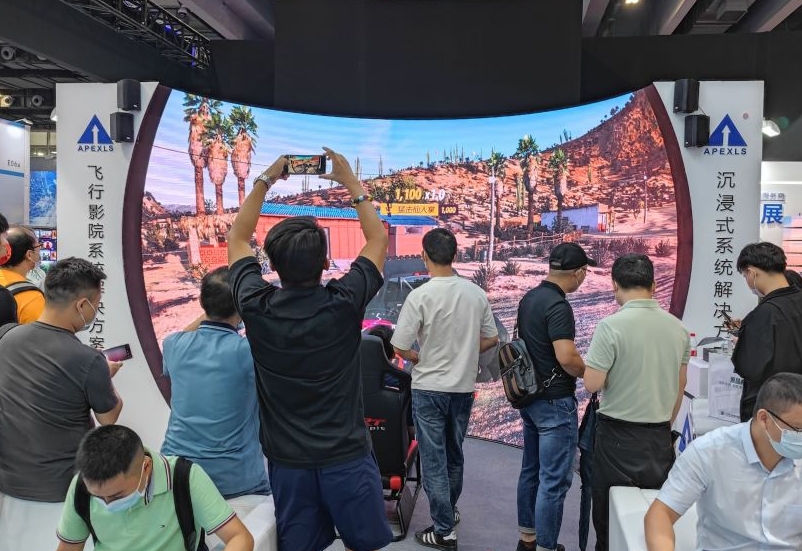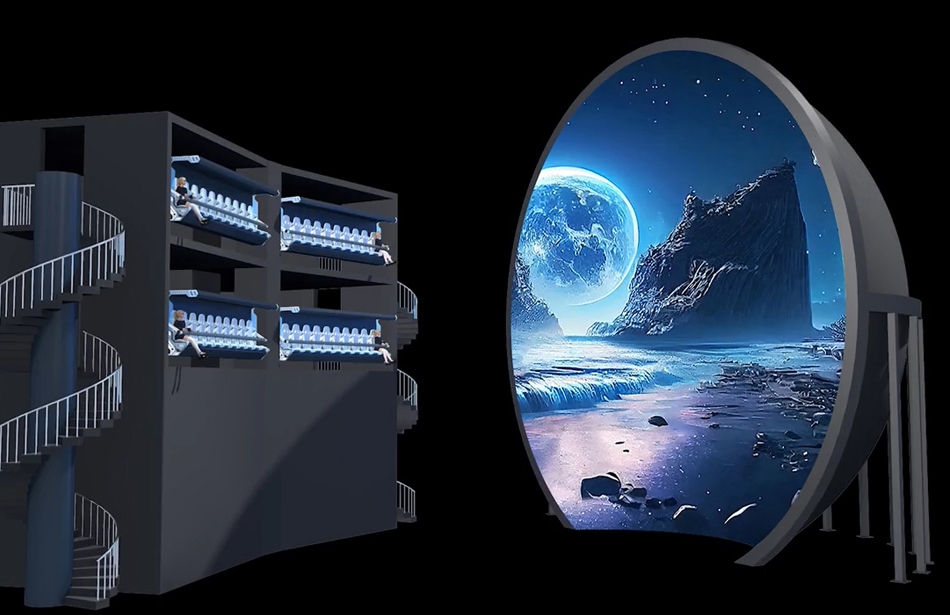
The functional positioning, dome diameter, and seating capacity of a dome theater are not isolated elements; they are interrelated and mutually influential, collectively shaping the overall quality of the theater and the audience experience. In-depth exploration of the interconnected design of these three aspects is of great significance for creating an efficient and high-quality dome theater in a science and technology museum.
I. Functional Positioning: The Core Guide for Theater Design
The functional positioning of a dome theater in a science and technology museum determines its construction direction and operation mode, serving as the starting point for the entire design.
(I) Popular Science Education
This is the primary function of a dome theater in a science and technology museum. By screening films on themes such as cosmic exploration, natural wonders, and biological evolution, and leveraging the immersive nature of the dome, the theater allows the audience to feel as if they are in scenarios like the vast universe or a mysterious rainforest. This enables the audience to intuitively perceive scientific phenomena and understand scientific principles. For instance, when screening a film about the formation of the solar system, the all-round visual presentation of the dome allows the audience to clearly see the birth and evolution process of planets. This is more impactful and engaging than traditional flat-screen displays, significantly enhancing the effectiveness of popular science education. To fulfill this function, the theater needs to be equipped with a professional library of popular science film resources, as well as docents capable of providing in-depth explanations of the film content. These docents can answer the audience's questions before and after the screening to strengthen knowledge absorption.
(II) Cultural Communication
The dome theater can serve as a platform for spreading regional culture and historical stories. For example, local ancient legends and major historical events can be adapted into dome films. Through unique visual presentation, these cultural heritages are brought to life. Taking the ancient maritime culture of a certain region as an example, a dome film can simulate the scene of towering waves. The audience feels as if they are on an ancient sailing ship, exploring the unknown alongside sailors. In this immersive experience, the audience gains an understanding of the local cultural heritage and develops a stronger sense of cultural identity. This requires the theater to focus on the exploration and presentation of cultural themes when producing or introducing films, ensuring the accuracy and vividness of cultural content.
(III) Entertainment Experience
On the basis of meeting the needs of popular science education and cultural communication, the dome theater provides the audience with a unique entertainment experience. Dynamic adventure films, fantasy sci-fi films, and other genres, combined with the dome's large screen and three-dimensional sound effects, offer the audience an exciting sensory experience. For example, some dome films that simulate roller coasters, with their rapid scene transitions and realistic sound effects, create a strong sense of weightlessness and speed for the audience, achieving the goal of entertainment and relaxation. However, the entertainment function must be organically integrated with popular science education to avoid excessive entertainment that deviates from the core purpose of the science and technology museum.
Inclined Dome Theater
II. Dome display Diameter: A Key Dimension Affecting Experience and Functional Implementation
The selection of the dome led display diameter is directly related to the audience's visual experience and the realization of the theater's functions, and is closely linked to the functional positioning.
(I) Small-Diameter Domes (10-15 Meters)
This type of led dome display is suitable for science and technology museums that prioritize popular science education and have limited space, such as community science and technology museums or small thematic science and technology museums. The smaller diameter reduces the distance between the audience and the screen. When screening content such as the microcosmic world or small-scale popular science experiments, the audience can clearly observe details, enhancing the precision of popular science education. However, due to size limitations, the grandeur and impact of the screen are relatively weaker, and the seating capacity is also smaller, generally ranging from 50 to 100 seats. It mainly serves small groups of audiences, such as school class study tours and small-scale popular science lectures.
(II) Medium-Diameter Domes (15-20 Meters)
This is a relatively common led dome display size, balancing the functions of popular science education, cultural communication, and entertainment experience. Its screen covers a wider range, capable of presenting grand natural scenes, historical battle scenes, and other content, meeting the screening needs of various types of films. In terms of seating capacity, it can accommodate 100 to 200 people, suitable for the daily screening of popular science films in the science and technology museum, and can also host small-scale cultural activities, such as premieres of local cultural themes. For example, an 18-meter-diameter dome theater in a medium-sized science and technology museum regularly screens films about the evolution of Earth's ecology. The moderate size allows the audience to not only feel the grandeur of the Earth but also clearly see ecological details, obtaining a good viewing experience.
Dome Theater System and Control Structure
(III) Large-Diameter Domes (Over 20 Meters)
Large-diameter domes are mostly used in large-scale science and technology museums, aiming to create an ultimate immersive experience. Taking a 30-meter-diameter dome as an example, its large screen area (exceeding 1,000 square meters) can create an extremely shocking visual effect. Whether it is presenting the vastness of the cosmic starry sky or recreating the spectacular scenes of the dinosaur era, it can make the audience feel as if they are in the real scene. In terms of functions, it focuses more on hosting large-scale popular science exhibitions, high-end cultural exchange activities, and the screening of commercial special-effect films. The seating capacity usually ranges from 200 to 500 seats, which can meet the viewing needs of a large number of audiences. However, the construction and operation costs are relatively high, and the requirements for film resources and screening equipment are more stringent.
III. Seating Capacity Configuration: Adapting to Functions and Dome Size
The reasonable configuration of seating capacity needs to comprehensively consider the functional positioning and dome diameter of the dome display theater to achieve a balance between space utilization and audience experience.
(I) Adjusting Seating Layout Based on Functional Positioning
Prioritizing Popular Science Education: If the theater mainly focuses on popular science education, the seating layout should emphasize the audience's line of sight and the effectiveness of explanations. A stepped arrangement can be adopted to ensure that the line of sight of the audience in the back row is not blocked, and each seat can clearly see the central area of the dome. At the same time, the spacing between seats can be appropriately increased to allow the audience to remain comfortable during long viewing sessions, facilitating their concentration on knowledge learning. For example, when holding a popular science lecture, the dome theater of a certain science and technology museum adjusts the seats into a fan-shaped layout facing the lecture platform, and some seats can be moved flexibly to adapt to different lecture formats and the audience's interaction needs.
Prioritizing Entertainment Experience: For dome theaters that mainly focus on entertainment experience, the seat design emphasizes comfort and immersion. Semi-reclining or inclined seats can be used to allow the audience to better integrate into the film scene and reduce fatigue during long viewing sessions. At the same time, in terms of seat distribution, the number of seats surrounding the screen can be appropriately increased, so that more audiences can obtain an all-round visual experience. For example, some dome theaters featuring dynamic films use specially designed seats that can achieve effects such as vibration and swaying in line with the film plot, enhancing the audience's sense of participation. In this case, a reasonable seating layout can ensure that each seat has a consistent special-effect experience.
(II) Determining Seating Capacity Based on Dome Diameter
Small-Diameter Domes: Due to limited space, small-diameter dome theaters have fewer seats. For a dome with a diameter of 10-15 meters, to ensure the audience has a good viewing angle and sufficient space, the number of seats is generally controlled between 50 and 100. For example, a dome theater with a diameter of 12 meters adopts a compact but reasonable layout, with 70 seats. Each seat allows a clear view of the dome screen, and the audience does not feel crowded.
Medium-Diameter Domes: The seating capacity of medium-diameter dome theaters can be adjusted between 100 and 200 seats according to actual needs. For an 18-meter-diameter dome, a relatively conventional seating layout can accommodate approximately 150 people; through optimized design, such as using lighter seats and rationally utilizing corner spaces, the number of seats can be increased to 180-200. For example, a science and technology museum renovated its 18-meter-diameter dome theater. By replacing the seats with new models and re-planning the aisles, the number of seats was increased from 150 to 180 without affecting the viewing experience, improving the theater's reception capacity.
Large-Diameter Domes: Large-diameter domes have more space, so the number of seats is correspondingly larger. A dome theater with a diameter of 23 meters typically has 200-300 seats; a large dome theater with a diameter of 30 meters can have 300-500 seats. However, as the number of seats increases, more attention must be paid to the audience's evacuation safety and viewing comfort. For example, a 30-meter-diameter dome theater has 400 seats. Through scientific zoning design, multiple evacuation channels are divided to ensure that the audience can evacuate quickly in case of an emergency; at the same time, the seats are carefully selected and arranged to ensure that each seat has a good viewing perspective and sufficient legroom.
The functional positioning, led dome display diameter, and seating capacity configuration of a dome theater in a science and technology museum are interdependent and mutually restrictive. During the design and construction process, the relationship between these three aspects must be fully considered. With functional positioning as the core, a reasonable dome diameter should be selected, and the seating capacity should be accurately configured. This will create a dome theater space that not only meets the needs of popular science education, cultural communication, and entertainment experience but also provides the audience with a high-quality audio-visual enjoyment.